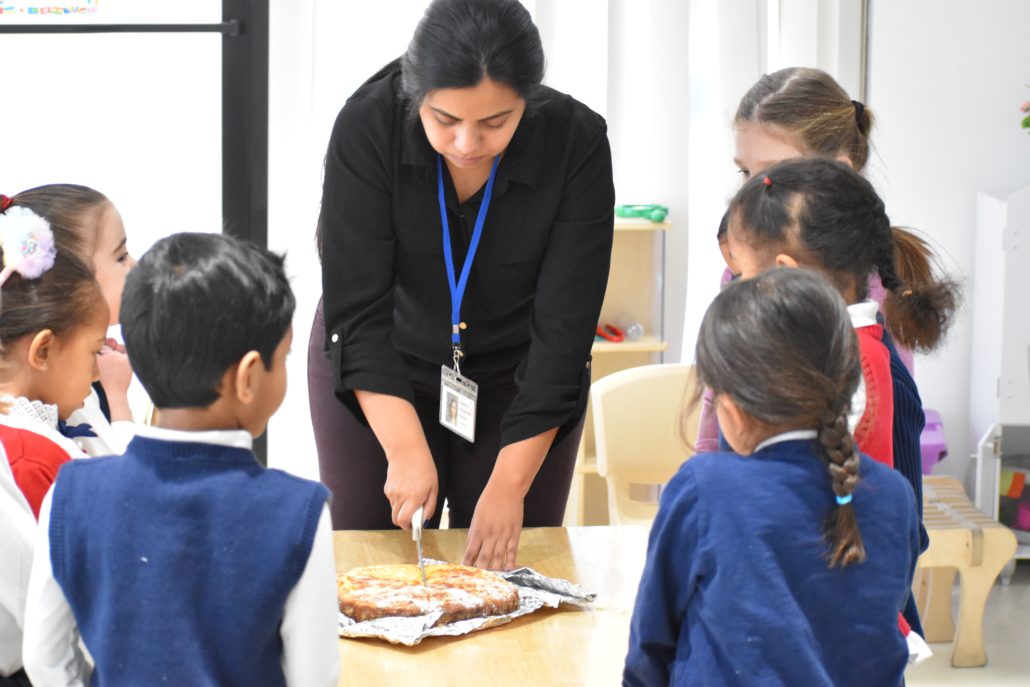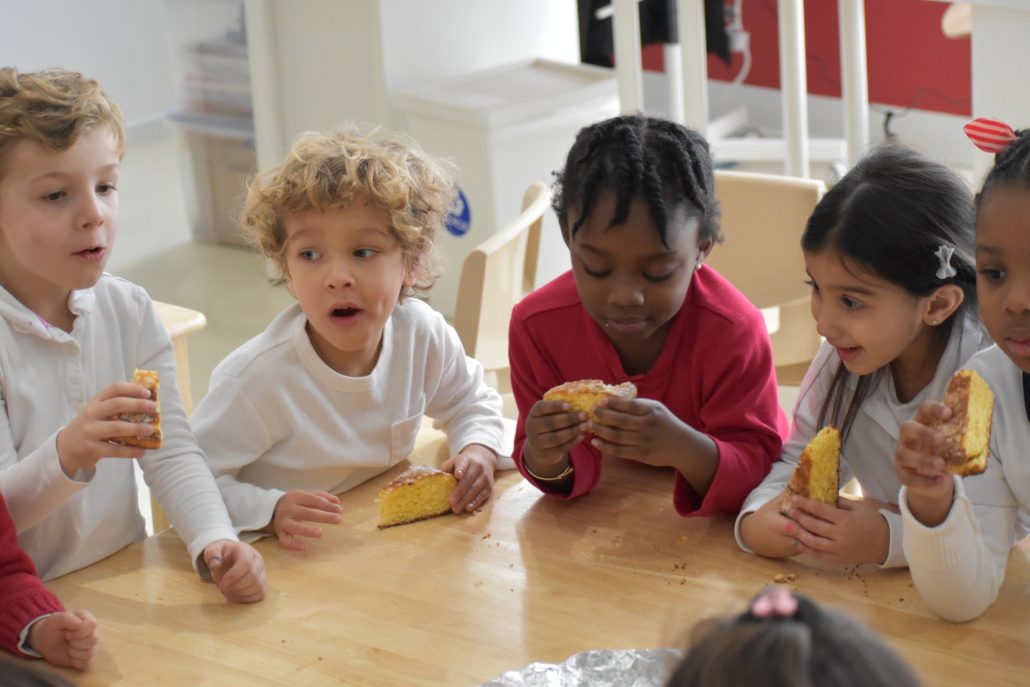Celebrating La Galette des Rois
At Tessa we celebrated the Galette des Rois on Tuesday, January 7th. Each class shared a cake and the lucky winners became kings and Queens of the day!

Why is it celebrated?
French families conclude the festive season with a rich pastry fit for kings. The Galette des Rois is a cake traditionally shared at Epiphany, on 6 January. The tradition of eating this cake dates back to the 14th century. It commemorates the moment when baby Jesus was presented to the Three Wise Men, Melchior, Caspar and Balthazar in Bethlehem. They arrived from and represent the three continents, Asia, Africa and Europe, to give their gifts.
What is the tradition?
The Galette des Rois isn’t just a cake, it is a ceremonial experience. First, the youngest child (and therefore the most innocent) goes under the table were they direct who should get which slice. If there are no children at the table, the cake is cut by the youngest person in the room. Whoever has the charm, or féve, in their slice, is crowned and chooses his or her king of queen. They both wear a paper crown usually provided with the cake. Careful when bitting into the cake, don’t break a tooth or swallow the féve! The féve is a porcelain or plastic figurine that represented the nativity and characters from the crib. Nowadays, there are a wide range of figurines, such as one of the three kings, Disney characters, animals, fruits, cars or even shoes. Féves are collectors items and their collectors are known as favophiles. In the 14th century they would use a white or black bean to hide in the cake.
Heavy is the head that wears the crown. Well, not to that extent! In some regions, the new crowned king or queen is given a choice between two tasks. They should either offer a beverage to everyone around the table, either sparkling wine or champagne, or volunteer to host the next Galette des Rois at their home. That way the festivities of Galette des Rois can be celebrated through all of January.

Is there only one type of Galette?
Eh, bien, non! The galette des rois taste has been modified in many ways by pastry chefs. For example, La Maison Dalloyau in Paris adds candied orange and Grand Marnier, top patissiers, Pierre Hermé, adds a creamy ganache while Maison Hédiard marries Bourbon Vanilla with the almond cream. Others have used apricots, nuts, spices, figs, honey, raspberry, even rose petals. Thus don’t hesitate to add you own unique touch of your favorite flavors!
Different regions in France have their own traditional kings cake. The northern half of France and Belgium the cake is the one we all know and love with the golden crust and frangipane, an almond filled paste. In the southern half of France, the cake is called a Gâteau des Rois and is a crown-shaped cake or brioche filled with fruit. Both equally delicious! In Switzerland, or Romandy, both types can be found though the latter is more common.
Some historical and contemporary changes:
- “In the past, the pastry would be cut into as many portions as there were guests, plus one. The last one, called the “part du pauvre” or poor man’s share, was for the first poor person who stopped by the house.”
- “They even played “find the king” at the table of Louis XIV. The ladies of the court who found the fève became queens of France for a day and could ask the king to grant them a wish called “grâces et gentillesse”. But the Sun King, Louis XIV, was to abolish this custom.”
- “Interestingly during the French Revolution the name was changed to “Gâteau de l’egalité” because a king was not quite well regarded during this time.”
- “Every year, during the traditional reception at the Elysée Palace, an enormous galette (measuring 1.2 m across for 150 people) is made for the President of the French Republic. But the artisan baker and pastry chef responsible for making it is instructed not to put a fève in the cake because “it would not be appropriate to find a king in the presidential palace of the Republic”.”
Hold off on your January dieting and loosen your belts because here are the ingredients of a traditional Galette des Rois:
INGREDIENTS
- 2 Sheets store-bought puff pastry
- ¼ cup (60 ml) almond paste
- 3 tbsp (45g) unsalted butter
- 3 tbsp (20g) powdered sugar
- 2 eggs
- 1 tsp (5ml) almond extract
- ¼ tsp (1.25ml) salt
- 2 tbsp (15g) all-purpose flour
- 1 egg beaten for egg wash
- piece of bittersweet chocolate or “féve”
INSTRUCTIONS
- Pre-heat oven to 400F (200C).
- In the bowl of an electric mixer beat together the almond paste, butter and powdered sugar until well combined. Then add eggs 1 at a time, beating in between each addition. Then add almond extract and salt and beat again. Lastly add flour and beat until combined. Set aside.
- Roll out puff pastry sheet onto a floured surface, making sure you have a flat rectangular with no seams remaining if your pastry came scored in any way.
- Cut out 2 10” inch circles with a dinner plate. Place one on a parchment-lined cookie sheet and set the other aside resting on a cutting board.
- Spread the almond cream on the circle on the cookie sheet leaving a 2” border. Brush border with egg wash, place “feve” or piece of chocolate anywhere in the cream.
- Place 2nd circle on top and press together to seal circles together.
- Create a decorative scallop along the edge of the circles by placing your two fingers at the top edge of the circle and pulling a butter knife towards you to pull the pastry towards you and create an indentation in the pastry. Continue all the way around the circle until a scalloped edge is formed.
- Brush the center part only of the circle with more egg wash.
- To firm up pastry before baking, place tray in fridge for 20 mins or the freezer for 10 mins.
- Bake at 400F (200C) for 25-30 mins. Serve warm or at room temperature.
- Slice into wedges. The guest that receives the slice of the cake with the “féve” or chocolate is King for the day!
NOTES
Be sure your puff pastry is extremely cold before you lace it in the oven. In fact, pop it in the freezer for 10 minutes before baking. This will prevent the pastry from melting too quickly and the filling seeping out. It will also help it puff up as it bakes.
Make sure your pastry mounds are well sealed with the egg wash, otherwise the filling will seep out.
You can make this cake ahead of time and either serve at room temperature or reheat for 10 minutes at 300F (150C)
Here is the recipe in French!
- 2 pâtes feuilletées
- 140 g de poudre d’amande
- 100 g de sucre fin
- 2 oeufs
- 75 g de beurre mou
- 1 jaune d’oeuf
- 1 fève
- Etape 1 Placer une pâte feuilletée dans un moule à tarte, piquer la pâte avec une fourchette.
- Etape 2 Dans un saladier, mélanger la poudre d’amandes, le sucre, les 2 oeufs et le beurre mou.
- Etape 3 Placer la pâte obtenue dans le moule à tarte et y cacher la fève.
- Etape 4 Recouvrir avec la 2ème pâte feuilletée, en collant bien les bords.
- Etape 5 Faire des dessins sur le couvercle et badigeonner avec le jaune d’oeuf.
- Etape 6 Enfourner pendant 20 à 30 min à 200°C (thermostat 6-7); vérifier régulièrement la cuisson !



















